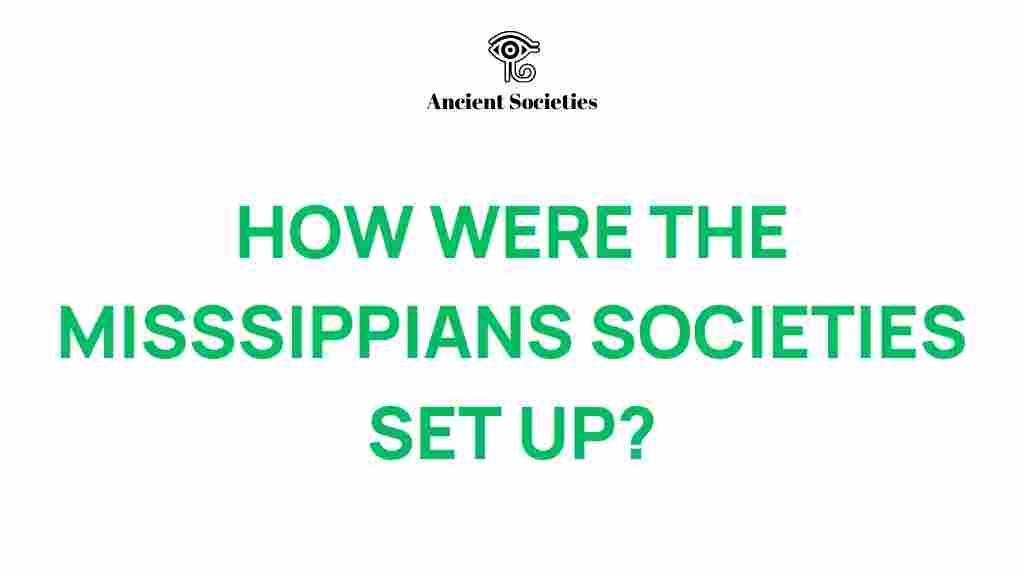Unraveling the Mysteries of Mississippian Societies
The Mississippian societies, an important part of ancient civilizations in North America, thrived from approximately 800 CE to 1600 CE. These societies were notable for their complex social structures, impressive mound-building practices, and extensive trade networks. Understanding the cultural practices and historical significance of the Mississippian peoples offers valuable insights into their way of life and their impact on future generations.
Understanding Mississippian Societies
Mississippian societies were characterized by a highly organized social hierarchy, with a chiefdom system that played a crucial role in governance and social organization. These indigenous peoples developed sophisticated agricultural techniques, allowing them to sustain large populations and build significant urban centers.
The Mound Builders: An Architectural Marvel
One of the most striking features of Mississippian societies is their construction of earthen mounds. These mounds served various purposes, including:
- Religious ceremonies: Many mounds were used for rituals and burials, acting as sacred spaces.
- Political centers: Some mounds were the sites of elite residences and governance.
- Defensive structures: Mounds also provided strategic advantages in conflicts.
The most famous mound site is Cahokia, located near present-day St. Louis, Missouri, which features the massive Monk’s Mound, one of the largest earthen structures in the Americas.
Cultural Practices of the Mississippian Peoples
The cultural practices of Mississippian societies were diverse and rich. They included:
- Agriculture: The Mississippians cultivated crops such as maize, beans, and squash, which formed the backbone of their diet.
- Artistic expressions: They created intricate pottery, jewelry, and textiles, often adorned with symbolic motifs.
- Religious beliefs: Their spirituality was deeply intertwined with nature, and they practiced various rituals to honor their deities.
These practices not only reflect the day-to-day lives of the Mississippians but also their values and beliefs.
Social Structures within Mississippian Societies
The social structures of Mississippian societies were hierarchical, with a clear distinction between the elite and commoners. Key components of their social organization included:
- Chiefs: The chief, often regarded as a political and spiritual leader, held significant power and influence.
- Elite classes: Nobility and priests occupied higher social ranks, often residing in larger mounds.
- Commoners: The majority of the population consisted of farmers, artisans, and laborers who performed essential tasks.
This hierarchy allowed for organized governance and social cohesion, fostering the development of complex societies.
Trade Networks and Economic Engagement
Mississippian societies established extensive trade networks that connected different regions, facilitating the exchange of goods, ideas, and cultural practices. Key aspects of these networks included:
- Geographic reach: Trade routes extended from the Gulf of Mexico to the Great Lakes, showcasing the vastness of their interactions.
- Goods exchanged: Items such as copper, shells, pottery, and textiles were traded, reflecting the diverse resources of the regions involved.
- Cultural exchange: Trade not only involved goods but also ideas, leading to cultural diffusion among different societies.
These trade networks were vital for the economic stability and cultural richness of the Mississippian civilizations.
Archaeological Discoveries and Historical Significance
Archaeology plays a crucial role in uncovering the mysteries of Mississippian societies. Excavations of mound sites have revealed:
- Artifacts: Tools, pottery, and ceremonial items provide insight into their daily lives and spiritual beliefs.
- Burial practices: Human remains and grave goods offer a glimpse into their social structures and rituals surrounding death.
- Settlement patterns: The layout of ancient cities informs us about their urban planning and societal organization.
The historical significance of Mississippian societies lies in their contributions to the cultural heritage of North America. Understanding their achievements helps us appreciate the complexity of indigenous peoples and their legacies.
Challenges in Understanding Mississippian Societies
While much has been learned about Mississippian societies, there are challenges that researchers face, including:
- Preservation issues: Many archaeological sites are threatened by modern development and environmental factors.
- Interpretation of findings: The meaning of artifacts can be subjective and may vary based on different cultural contexts.
- Limited written records: Much of the knowledge about these societies has been passed down through oral traditions, making it challenging to piece together a complete history.
Addressing these challenges requires collaboration among archaeologists, historians, and indigenous communities to ensure that the stories of Mississippian societies are accurately told and preserved.
Troubleshooting Tips for Exploring Mississippian Sites
If you are interested in exploring Mississippian archaeological sites, here are some tips to enhance your experience:
- Research before visiting: Familiarize yourself with the site’s history and significance.
- Respect the site: Follow guidelines and regulations to protect archaeological resources.
- Engage with local experts: Guided tours can provide valuable insights and deeper understanding.
For further reading on Mississippian societies and their impact, check out this comprehensive resource.
Conclusion
Mississippian societies represent a fascinating chapter in the story of ancient civilizations in North America. Their cultural practices, social structures, and remarkable trade networks highlight the sophistication of these indigenous peoples. Through archaeological discoveries and ongoing research, we continue to unravel the mysteries surrounding the mound builders and their historical significance. By appreciating their contributions, we can honor the legacy of the Mississippian societies and their enduring impact on our understanding of North America’s past.
For more information on ancient civilizations, visit this informative site.
This article is in the category Archaeology and created by AncientSocieties Team
